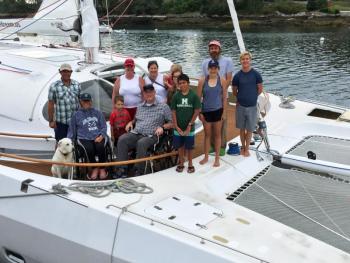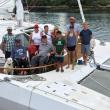The Impossible Dream continues to make dreams realities
 On Aug. 16, the Impossible Dream set sail from Boothbay Harbor with a group of sailors, including paraplegic Bob Gregoire and quadriplegic Phil Oliver (not pictured). SUZI THAYER/Boothbay Register
On Aug. 16, the Impossible Dream set sail from Boothbay Harbor with a group of sailors, including paraplegic Bob Gregoire and quadriplegic Phil Oliver (not pictured). SUZI THAYER/Boothbay Register
 Bob and Cathy Gregoire on the Impossible Dream. SUZI THAYER/Boothbay Register
Bob and Cathy Gregoire on the Impossible Dream. SUZI THAYER/Boothbay Register
 First Mate Evan Duffy enjoys some grub aboard the Impossible Dream. SUZI THAYER/Boothbay Register
First Mate Evan Duffy enjoys some grub aboard the Impossible Dream. SUZI THAYER/Boothbay Register
 Captain Will Rey and young sailing enthusiast Hamilton Barclay. SUZI THAYER/Boothbay Register
Captain Will Rey and young sailing enthusiast Hamilton Barclay. SUZI THAYER/Boothbay Register
 On Aug. 16, the Impossible Dream set sail from Boothbay Harbor with a group of sailors, including paraplegic Bob Gregoire and quadriplegic Phil Oliver (not pictured). SUZI THAYER/Boothbay Register
On Aug. 16, the Impossible Dream set sail from Boothbay Harbor with a group of sailors, including paraplegic Bob Gregoire and quadriplegic Phil Oliver (not pictured). SUZI THAYER/Boothbay Register
 Bob and Cathy Gregoire on the Impossible Dream. SUZI THAYER/Boothbay Register
Bob and Cathy Gregoire on the Impossible Dream. SUZI THAYER/Boothbay Register
 First Mate Evan Duffy enjoys some grub aboard the Impossible Dream. SUZI THAYER/Boothbay Register
First Mate Evan Duffy enjoys some grub aboard the Impossible Dream. SUZI THAYER/Boothbay Register
 Captain Will Rey and young sailing enthusiast Hamilton Barclay. SUZI THAYER/Boothbay Register
Captain Will Rey and young sailing enthusiast Hamilton Barclay. SUZI THAYER/Boothbay Register
On Aug. 16, the Impossible Dream sailed into Boothbay Harbor again, just short of a year after its first trip here last year.
The boat left Florida in June and headed up the east coast, and owner Deborah Mellen and her best friend, a yellow lab named Winter, joined Captain Will Rey and First Mate Evan Duffy, and a couple other passengers, in Baltimore in late June. She and the crew stopped in New York, Newport, Rhode Island, Martha's Vineyard, Boston and Kennebunk before tying up at Hodgdon Marina.
A universally designed, ocean-going 60-foot catamaran with an 85-foot mast, Impossible Dream is used to help make dreams come true for people with disabilities. The universally accessible sailboat was the idea of paraplegic Mike Browne, who had a dream of sailing a boat that was fully operational to anyone in a wheelchair.
Mellen, a wheelchair user due to spinal cord injuries sustained in an automobile accident in Italy, has made the Impossible Dream and its life altering adventures her life's work. Her partner in the venture, Harry Horgan, also a wheelchair user, is co-founder and president of Miami-based Shake-a-Leg, an organization started to help him and others with mobility disabilities maximize their independence through sailing.
During her stay in Boston, Mellen worked with recently disabled people at Spaulding Hospital. There she met Kristin Johnston, an occupational therapist who had been working with Bob Gregoire, a paraplegic and the chief of police in Augusta. Gregoire and his wife Cathy had spent 10 weeks at the rehab center after a motorcycle accident in 2014 caused an upper spinal cord injury that left him unable to move any part of his body.
On Aug.16, Mellen and her crew took Gregoire and his wife, and Johnston, for a sail.
Before heading out, Gregoire spoke about his accident, and said he was feeling lucky. He had started walking. “My first diagnosis was that I was a quadriplegic. I was on a respirator, and they didn't know if I'd be able to breathe on my own.” After six weeks at Spaulding, he could only move his right thumb.
The day after Christmas last year, he was trying to squeeze his thigh muscle, and it moved. “There was no jumping for joy, but I cried,” he said.
“I've been very fortunate. We started in a pool, and slowly I was able to stand up. From there we went to a lift with a harness. I was just like a baby. I had to learn to walk again.”
The first time he walked without a harness was in March, and now he can walk a couple hundred feet at a time.
Occupational therapists, like Johnston, work with patients with disabilities from the waist up. Physical therapists focus on the waist down. Gregoire attributes a lot of his “luck” to Johnston, with help from a physical therapist. “We've been working with Kristin since January, 2015,” he said. “She filled in one day for another therapist, and at the end of the day I told Cathy we were switching therapists.”
“There's always hope,” Gregoire said.
In an email, Gregoire spoke of his experience on the Impossible Dream. “I really enjoyed the sail. It was very relaxing and the views were beautiful. I also enjoyed the opportunity to speak with other handicapped individuals about their challenges and accomplishments.”
A brother of a close friend of Mellen's in Miami, Mike Beauregard from Southport, went for the sail with his daughter, Ella, and her friend and fellow sailor, Hamilton Barclay of Boothbay. Recently both had competed and won their division in the Boothbay Harbor Yacht Club Regatta.
Also along on the sail was Phil Oliver, a quadriplegic, who came down from Washington County and arrived just in the nick of time. The Impossible Dream had given up on him and headed out when they heard a loud blast from a car horn. They turned around and picked him up, to his relief. He had, after all, just made a five-hour drive to experience his first sail on a boat that was fully equipped to be manned by someone in a wheelchair.
”It was worth every mile we drove to have an opportunity for a sail on this incredible craft,” he said.
“It was fascinating for me in at least a couple of ways. Meeting other wheelchair-bound people living active and useful lives — Augusta's chief of police along with the Impossible Dream founder — each inspired me in different ways. And this boat herself, an incredible amalgamation of an ancient Polynesian outrigger and a computerized, fully automated sailboat which can be piloted by a quadriplegic! This is, ‘mission to Mars,’ kind of stuff in my opinion.
“I feel more ‘awake’ than I have in a long time, imagining the possibilities that still can exist for me as a fatal car crash survivor. I have been in a wheelchair for a little longer than 11 years — a C5 quadriplegic — and I have regressed, admittedly. The normal problems we all face in life can get us a little down — whether we're in a wheelchair or out running marathons. Meeting Deborah, and her companion with the white fluffy tail, along with Captain Will and his crew helped me to realize what a lucky guy I really am. It's people like this who willingly give their time to help others, that really make a difference in this world. They really made an impossible dream a reality for me.”
First Mate Duffy, who has been on the boat for six months, said working on the Impossible Dream is a rewarding experience. “I get a lot of pleasure from being on this boat, doing what we do. I keep getting surprised by all the smiles that come off the boat. It's so rewarding.”
Read about the Impossible Dream and her first trip to Boothbay Harbor last year in the Sept. 3, 2015 edition of the Boothbay Register.
Event Date
Address
United States




























